Wolter & Teubner's Basic Wheat Germ Recipe, Revised,
and made with my Homemade Malt
and either Sunflower Seeds or Cracked Wheat
Prologue to Tears
You'd think that because I'm a palliative care nurse, I'd grow a spine. You'd think that I'd become toughened, hardened, inured to pain and suffering and loss. Nuh uh. Think again.
I'm a wimp. I tend to tear up easily. One of my most embarrassing moments of tearfulness came when I sat in a theatre and watched the animated movie, "Toy Story" for the first time, and the lights came up and I was sitting there bawling my eyes out.
Now, if it was "Bambi", and the fawn's mother had just died, perhaps we could understand it. But the happy ending of "Toy Story"? For heaven's sake, get a grip! It is just an animated movie...
Today's Experimental Loaves
Today I made another variation of the Wolter & Teubner Wheat Germ Loaf. After the last time I made this, I didn't add any oil this time, and I added the salt at the beginning. But I included a couple of other ingredients to see what would happen.
(i) Sunflower seeds
The sunflower seeds were an obvious choice: I've been meaning to add these for some time now, because the nutty taste really begs for the flavour of these seeds. So one of the breads I've made today contains 1/3 cup of these tasty seeds. The ones I used were unsalted, but were roasted. They weighed 46g.
(ii) Cracked Wheat
The other loaf that I made used cracked wheat instead of sunflower seeds. Rather than use 1/3 of a cup, I opted to use the same amount of weight as the sunflower seeds -- which meant somewhat more cracked wheat, by volume. Now here is the curious thing about adding the cracked wheat: the dough that resulted was substantially wetter. I would have thought the reverse would happen. But the cracked wheat, having more volume, took longer to knead together, and perhaps the heat of my hands and the friction from that motion caused the dough to act wetter, who knows? The sunflower seed dough was almost entirely mixed by a spoon, and required very little kneading to get the ingredients to an even consistency. Otherwise I just can't explain it.
(iii) Malt
The last ingredient I added to both loaves. This is the first time ever I have used malt. I have looked for malt in stores, and never found it. I think that you can buy malt extracts at certain places, but again, I've never seen it in the stores. Someone suggested that I might be able to find it in a "Brew your own beer" place. Alas, there doesn't' seem to be any local self-breweries where I live, and I haven't been to the nearest city specifically to look there.
So, without any experience, I decided to make my own.
Making Malt
According to the current Wiki on Malt,
"Malting is a process applied to cereal grains, in which the grains are made to germinate by soaking in water and are then quickly halted from germinating further by drying with hot air."
I have very little experience with sprouting anything. But here I am, with some mug beans, some adzuki beans, and some wheat, in mason jars, to see what will happen. I am using about 1/4 cup of each bean or berry per jar (well, I might have put a bit more wheat in than that -- although I probably shouldn't have).
The books I referenced to try this said I had to soak them overnight, and then drain them and put them in a warm, dark place, rinsing them with water 3-4 times a day. This went well for the first couple of days, and then forgetfulness set in. If these things could be left out, I might have remembered; but because they were tucked away in a dark cupboard, I kept forgetting them. Rinsing fell to once a day, then for a couple of days I completely forgot. When I'd remember again, I'd give them a good soaking prior to a rinse.
Because of that, the adjuki beans (which didn't sprout too well at all) and the mung beans (which sprouted a little but not a lot) got fed to the chickens. The wheat berries sprouted fine, but were difficult to get out of the jar, they were so thick.
I almost roasted them, but that would have been a mistake. The books say you have to leave them to dry in the sun for 3 full days. Well, I didn't have the sun or climate for that. Instead, I stuck them in my Excalibur Dehydrator for a 24 hour period of drying. Then I immediately refrigerated them.
I had forgotten them until today's breadmaking, when I decided to include them in the bread.
After measuring the malt for some dough, I grabbed a small mouthful to see if they tasted all right.
And that is when I started, almost inexplicably, to cry.
What was going on?
A Taste is a Scent is a Memory is a Tear
With the single taste of my home-made malt, I was transported in time to when I was a boy on my Grandparent's farm. My Grandfather was holding a threshing bee. He was interested in steam engines, and owned a few. As a machinist and mechanic, he had restored several in his shop, even building his own from scratch. He also owned a threshing machine. Every other year when I was growing up, he would invite family and friends and acquaintances to come to his farm, and he would thresh his grain the old fashioned way. As kids, we got to see first hand, up close and personal, every step of the process. My Grampa loved the community event. My Gramma too loved the excitement and chaos of the kitchen and dining room as family and friends filled her house and their bellies after the long day in the fields.
My cousins Jim and Janice and I would move from one area of interest to the next: whether it was tossing sheaves onto the wagons, or toting water and lemonade for the men, or observing the Möbius-twisted belts that turned the threshing machine's flywheels, we raced about madly, taking it all in. We nosed about the kitchen until we were told to get out from underfoot. We ran to the fields over stubbles of straw. We climbed into the grain wagon while it was being filled by the thresher, shovelling it needlessly into the corners, burying ourselves under the warm stream of grains just for fun. Later we would leap from the top of the pile of chaff and straw, getting it under our clothes and in our hair, loving everything about the day.
The taste of malt for me is the taste of newly threshed grain, still bursting with green life as it comes out of the thresher. It is the sound of the steam engine, struggling under the load of the giant belt it is turning. It is the ploddingly slow ride back to the shed where the steam engine was kept, after the long day was over, with Grampa at the wheel. It is the memory of my Grandfather, who put together this huge event not just because he loved it, but because he wanted to share it with us. It was already an anachronism in my day, and in my mother's day. The harvest of grain no longer happens this way. It was an event that clearly came from my Grandfather's youth. It was something he wanted to give to us, the experience of a threshing bee.
That is what I tasted today when I took a first mouthful of my home-made malt. A sweep of bittersweet memory bound in the taste of a germinated, dried grain.
Remembering him and his gift to us, I began to cry, grief-stricken for what I had lost, and indeed, for what the entire world has lost, because of the way we do things now.
I may not be making malt correctly. It is the first time I ever tried. But there was something fresh and interesting in this taste that reminded me of the life I once had as a boy on my Grampa's farm. Even if it was not officially correct, something here was right.
But would this taste-as-memory translate into the bread I would make with it?
The Malted Breads
The ingredients are much the same as I've been using, except without the oil:
- 100% Whole Wheat Flour 466g
- 15% Wheat Germ 70g
- 77% Water 359g
- 1% Yeast 3g
- 1.3% Salt 6g
- 10% Honey 47g
- 2.6% Malt 12g
- OPTIONAL:
- 10% Sunflower Seeds 46g
- or
- 10% Cracked Wheat 46g
Method
I mixed up the ingredients, kneaded it briefly to incorporate it all,
(i) Cracked Wheat:
(ii) Sunflower:
and let it sit for 4 hours.
At that time, I folded it and made a boule shape. It would proof in a floured banneton for 45 minutes; the last 30 minutes I preheated the stone and the pan in the oven.
(i) Cracked Wheat:
(ii) Sunflower:
Just before sliding the loaf in with a cornmeal-coated peel, I scored the loaf and sprinkled some water on its surface. It baked for 50 minutes at 400 degrees F.
(i) Cracked Wheat:
I mixed up the ingredients, kneaded it briefly to incorporate it all,
(i) Cracked Wheat:
(ii) Sunflower:
and let it sit for 4 hours.
At that time, I folded it and made a boule shape. It would proof in a floured banneton for 45 minutes; the last 30 minutes I preheated the stone and the pan in the oven.
(i) Cracked Wheat:
(ii) Sunflower:
Just before sliding the loaf in with a cornmeal-coated peel, I scored the loaf and sprinkled some water on its surface. It baked for 50 minutes at 400 degrees F.
(i) Cracked Wheat:
(ii) Sunflower:
Results
Although I state above that this is a 77% hydrated loaf, the wheat germ and the cracked wheat in the one loaf, along with the malt, probably will bring down this percentage to a number of 60% (although the honey might bring it up to 74% again). Similarly, you might count the sunflower seed loaf as 66%, or with the honey included in the hydration, you might think it is 74%. I can't explain why the cracked wheat loaf seems wetter by feel -- it shouldn't be, but it is.
Both breads had a fairly nice oven spring, and I was pleased with how they looked (although the scoring dragged the dough a bit, and I wasn't impressed with that). Compared to an earlier try at this recipe, I would say that I am beginning to get to something that begins to look acceptable.
I am also beginning to make the bread my own, with my own additions (and subtractions). For me, this has been a fun journey!
We cracked into these breads this evening. The word from the wife is, "they both are good." The nuttiness is quite pronounced. The crust, while it doesn't look at all like W&T's from their book, is nevertheless quite nice - crisp and crunchy and light. The bread might be a trifle dry on the crumb, but it tastes quite nice with some butter on it. And cheese. Over all, I'm happy with these loaves. I think I prefer the one with sunflower seeds, by a small margin.
(i) Cracked Wheat:
(ii) Sunflower:
Both of the loaves retained their shape, so I guess I have pretty much found the proper hydration, more or less.
(i) Cracked Wheat:
(ii) Sunflower:
Both of the loaves retained their shape, so I guess I have pretty much found the proper hydration, more or less.
Notes to Myself
- Do you need the honey?
- When is it best to add the salt? I have recently replied to a blogger at "Wild Yeast" who wrote about salt's function in the bread, and we discussed this briefly. She seems to feel that it would be a good idea to add salt to a bread, even if late, but it needs to be somewhat dissolved first. This would, of course, change the hydration percentage a bit, so the flour might also similarly have to be adjusted, especially on loaves like mine which are (I've been told) too wet to begin with.
- I have begun to write research notes for a "Calculus of Bread". I really am quite ignorant of many things, and I have a hunger to know.
- So what do you think about the home-made malt? Is it worth it, putting it into bread at these amounts? Something I read suggests that it will contain lots of proteases, and thus hurt the gluten. But for a single rise dough like this, it seems to work okay. Only occasionally can the malt be seen in the loaf. It does impart a texture, a crunchiness, but not so much flavour, more a subtle scent. I could conceivably put more into a loaf this size.

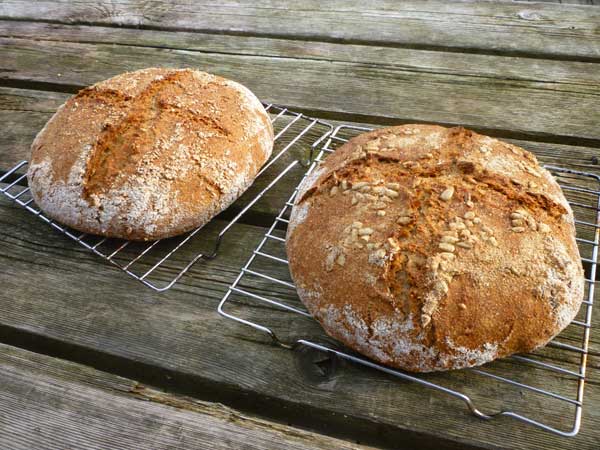








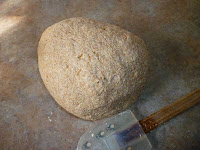




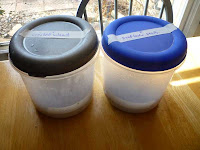





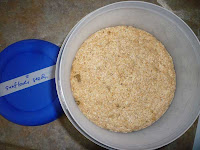


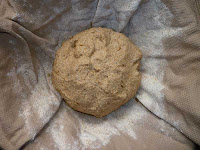















No comments:
Post a Comment